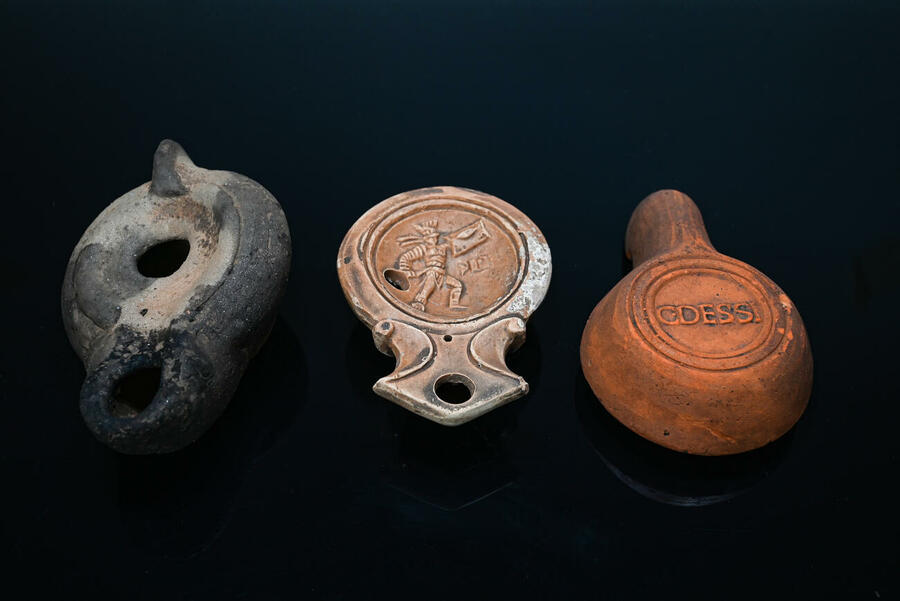Traces of the past under Emonika
The exhibition New Roman Discoveries under Emonika, which presents valuable archaeological finds discovered during the construction of the Emonika complex, will be on display in the Treasury of the Ljubljana City Museum until 1 June 2025.
A photographic exhibition highlighting the background of archaeological excavations at the Emonika archaeological site is on display at the Krakovski nasip embankment.
More about archaeological excavations
The archaeological excavations, which were carried out before the construction of the Emonika multifunctional complex, were conducted in the spring and summer of 2024. They uncovered parts of the northern cemetery of Emona that had not yet been explored.
The northern cemetery of Emona stretched to the left and right of today's Dunajska cesta road in the section between the square Kongresni trg and the Ljubljana Exhibition and Convention Centre Gospodarsko razstavišče. As 2000 years ago, this road still leads today towards the former Celeja, today's Celje, Petovija/Ptuj and further towards the Danube. This archaeological excavation revealed 183 Roman graves along the Dunajska cesta road, the foundations of grave plots and a side road that led from the main road to the east. Along this road, the foundations of a cemetery building of a smaller local cemetery were explored, where another 45 Roman graves were discovered. In addition, the research in the area of the future Emonika has brought another important discovery: traces of the land division of Emona, which despite intensive research have not been found so far. These are traces of the parcelling of agricultural land that the Romans carried out when they occupied this area and distributed the land to colonists.
194 cremation and 34 skeleton graves were discovered
In the archaeological research area, 194 cremation graves were discovered, mainly dating from the first two centuries AD. The cremated remains of the deceased were buried – with or without an urn – in pits dug into the ground, which were sometimes covered with tegulae (roof tiles almost half a metre long), bricks or stone slabs. Burials in amphorae, ash chests or masonry tombs were rare in this section of the northern cemetery of Emona. In addition to the cremation graves, 34 skeleton graves with 42 skeletons were also discovered. Namely, in some burial pits, several deceased were buried together. The skeleton graves mostly date back to the 3rd and 4th centuries. Burials in coffins and also without coffins were common, only once was a burial in a structure made of roof tiles found, and three deceased were buried in sarcophagi.
Precious objects that accompanied the deceased to the afterlife
The Romans believed that their souls lived on in the afterlife. They therefore buried various objects with the deceased that they might need in the afterlife: clothing, rare weapons, tools, oil lamps, dishes, money, toiletries, jewellery, perfume, food and drink. Among the accessories discovered in the Roman graves at the site of the future Emonika, ceramic and glass vessels were the most common, but they were rarely preserved intact. Only in two graves did a glass vessel serve as an urn; only one was preserved intact, namely a glass pot urn from an amphora burial, in which the deceased was also accompanied by three glass embalmers, a glass goblet and a coin. Glass beer vessels were found most frequently, in particular goblets, cups, bottles and flasks. There were also many glass embalmers in which scented oils and other valuable cosmetic liquids or substances were stored. In addition to vessels, pieces of jewellery, such as necklaces, were also found in the graves; only glass beads, which were once strung on strings, have been preserved. A fully preserved clothespin was also discovered. A silver stylus with a hexagonal handle was also found in one of the graves, and a well-preserved mirror in two others.
Outstanding discoveries
One of the graves with the highest number of discovered objects is a grave in which 122 small iron pins were found. Such pins were used in Roman times to reinforce the soles of shoes. They are often found along former Roman roads and in graves where they have been preserved while the leather of the shoes has rotted away. The imprint of such a shoe reinforced with pins is sometimes found on Roman bricks. A woman's grave was also very rich in accessories, with an abundance of jewellery from the 4th century. On her left hand, the deceased wore four bronze bracelets, two simple and two with ends in the shape of snakeheads. On her right hand, she wore a silver ring with a green glass insert. She also wore a necklace made of 15 dark blue glass beads with silver loops for fastening, and at her feet was a small ceramic vessel containing food or drink. Two other rich graves were excavated nearby, each containing a single gold wire earring among other items. One of the earrings was adorned with a horizontally arranged green semi-precious stone, possibly an emerald.
Important discoveries from the periods after the decline of Emona
There are only a few traces of settlement from the period after the fall of Emona. The remains of a much later building, which was erected as part of the construction of the railroad station in 1848 and demolished before 1910, are impressive. In addition, remains from the time of Italian occupation during the Second World War have also been discovered: these are the ruins of a concrete bunker dug into the ground and a circular masonry structure with a diameter of 16 meters, which is interpreted as the site of an anti-aircraft cannon. The two locations were connected by zigzag trenches.
The exhibitions are the result of a collaboration between the Ljubljana City Museum, the Stik Group, the Emonika multifunctional complex, whose investor is the company Mendota Invest, and Ljubljana Tourism.


